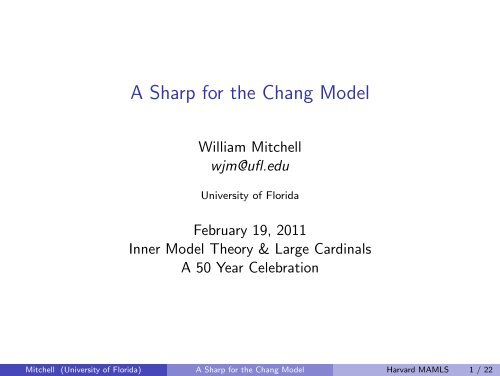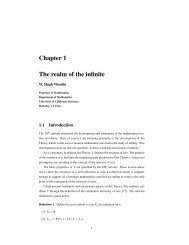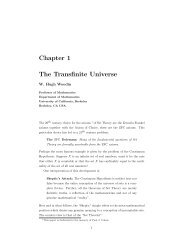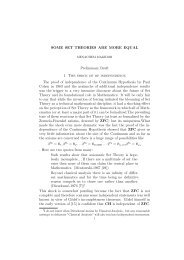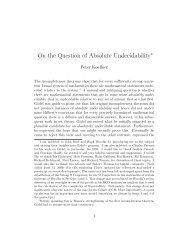A Sharp for the Chang Model - Logic at Harvard - Harvard University
A Sharp for the Chang Model - Logic at Harvard - Harvard University
A Sharp for the Chang Model - Logic at Harvard - Harvard University
Create successful ePaper yourself
Turn your PDF publications into a flip-book with our unique Google optimized e-Paper software.
2011-02-21A <strong>Sharp</strong> <strong>for</strong> <strong>the</strong> <strong>Chang</strong> <strong>Model</strong>OutlineOutline1 Wh<strong>at</strong> is <strong>the</strong> <strong>Chang</strong> <strong>Model</strong> C?2 Introducing <strong>the</strong> <strong>Sharp</strong>3 A Sketch of <strong>the</strong> ProofThese are <strong>the</strong> slides which I used <strong>for</strong> my talk <strong>at</strong> <strong>the</strong> MAMLS meeting <strong>at</strong><strong>Harvard</strong> <strong>University</strong>, “Inner <strong>Model</strong> Theory & Large Cardinals—A 50 YearCelebr<strong>at</strong>ion” on February 19, 2011. I have corrected (but not, I believe,all) of <strong>the</strong> typos and have added some notes.The <strong>for</strong>cing used in this paper is based on th<strong>at</strong> of Gitik in his proof of <strong>the</strong>independence of <strong>the</strong> SCH. The argument th<strong>at</strong> a generic set <strong>for</strong> <strong>the</strong><strong>for</strong>cing can be constructed using <strong>the</strong> indiscernibles coming from <strong>the</strong>iter<strong>at</strong>ion is based on work of Carmi Merimovich.
DefinitionDefinitionThe <strong>Chang</strong> model C is <strong>the</strong> smallest model of ZF containing <strong>the</strong> ordinalsand containing all of its countable subsets.It can be obtained by modifying <strong>the</strong> definition of L <strong>at</strong> ordinals α ofcofinality ω:C α+1 = Def Cα∪[α]
Simple Observ<strong>at</strong>ionsR ⊆ C, and hence L(R) ⊆ C.C s<strong>at</strong>isfies DC (Dependent choice), and any integer game decided inV is decided in C.Any member of C is definable in C by using a countable sequence o<strong>for</strong>dinals as a parameter.[C]
ExamplesC L = L.¬0 ♯ =⇒ C = L([ω 2 ] ω ).In L[U], let i U ω : L[U] → Ult ω (L, U) = L[U ω ].ThenC L[U] = L[U ω ][〈 i U n (κ) | n < ω 〉]= L[〈 i U n (κ) | n < ω 〉]andHOD CL[U] = L[U ω ].The point is th<strong>at</strong> U ω can be reconstructed from its Prikry sequence〈 i U n (κ) | n ∈ ω 〉, which is countable.Mitchell (<strong>University</strong> of Florida) A <strong>Sharp</strong> <strong>for</strong> <strong>the</strong> <strong>Chang</strong> <strong>Model</strong> <strong>Harvard</strong> MAMLS 5 / 22
Examples, continuedWith more measures, we have <strong>the</strong> <strong>the</strong>orem of Kunen:Theorem (Kunen)If <strong>the</strong>re are uncountably many measurable cardinals, <strong>the</strong>n <strong>the</strong> Axiom ofChoice is false in C.Mitchell (<strong>University</strong> of Florida) A <strong>Sharp</strong> <strong>for</strong> <strong>the</strong> <strong>Chang</strong> <strong>Model</strong> <strong>Harvard</strong> MAMLS 6 / 22
Examples, continuedNever<strong>the</strong>less, if V = L[U] <strong>for</strong> a sequence U of measures <strong>the</strong>nC = L[an iter<strong>at</strong>e of U]({all countable sequences of critical points})= L[({all countable sequences of critical points})HOD C is an iter<strong>at</strong>e of L[U].and if K = L[U] <strong>the</strong>n, by <strong>the</strong> covering lemma,C = L([ω 2 ] ω )({countable sequences of critical points}).Mitchell (<strong>University</strong> of Florida) A <strong>Sharp</strong> <strong>for</strong> <strong>the</strong> <strong>Chang</strong> <strong>Model</strong> <strong>Harvard</strong> MAMLS 7 / 22
Where does this fail?Woodin gave an upper bound:Theorem (Woodin)If <strong>the</strong>re is a measurable Woodin cardinal, <strong>the</strong>n <strong>the</strong>re is a sharp <strong>for</strong> <strong>the</strong><strong>Chang</strong> model.Mitchell (<strong>University</strong> of Florida) A <strong>Sharp</strong> <strong>for</strong> <strong>the</strong> <strong>Chang</strong> <strong>Model</strong> <strong>Harvard</strong> MAMLS 8 / 22
Wh<strong>at</strong> this meansThere is a closed, unbounded class I of ordinals such th<strong>at</strong> <strong>the</strong> followingholds: Say B ⊆ I is suitable ifThenB is closed and countable, andevery successor member of B ei<strong>the</strong>r is a successor point of I or hasuncountable cofinality.If B and B ′ are suitable and have <strong>the</strong> same length, <strong>the</strong>nC |= (φ(B) ⇐⇒ φ(B ′ )) <strong>for</strong> all <strong>for</strong>mulas φ.The <strong>the</strong>ory of C (with parameters <strong>for</strong> suitable sets) is fixed.There are Skolem functions (not in C) such th<strong>at</strong> C is <strong>the</strong> hull of Rand [I ]
QuestionQuestion (Woodin)With only measurable cardinals, K HODC is an iter<strong>at</strong>e of K.With a measurable Woodin cardinal, we have a sharp <strong>for</strong> C.Wh<strong>at</strong> happens inside this large gap? Does HOD C continue to be aniter<strong>at</strong>e of K C ?When Woodin asked this in a convers<strong>at</strong>ion <strong>at</strong> <strong>the</strong> Mittag-Leffler Institute,James Cummings and Ralf Schindler st<strong>at</strong>ed th<strong>at</strong> arguments of Gitiksuggested th<strong>at</strong> this would break down <strong>at</strong> o(κ) = κ +ω .I demurred, thinking th<strong>at</strong> this situ<strong>at</strong>ion was different.I was wrong.Mitchell (<strong>University</strong> of Florida) A <strong>Sharp</strong> <strong>for</strong> <strong>the</strong> <strong>Chang</strong> <strong>Model</strong> <strong>Harvard</strong> MAMLS 10 / 22
2011-02-21A <strong>Sharp</strong> <strong>for</strong> <strong>the</strong> <strong>Chang</strong> <strong>Model</strong>Introducing <strong>the</strong> <strong>Sharp</strong>QuestionQuestionQuestion (Woodin)With only measurable cardinals, K HODC is an iter<strong>at</strong>e of K.With a measurable Woodin cardinal, we have a sharp <strong>for</strong> C.Wh<strong>at</strong> happens inside this large gap? Does HOD C continue to be aniter<strong>at</strong>e of K C ?When Woodin asked this in a convers<strong>at</strong>ion <strong>at</strong> <strong>the</strong> Mittag-Leffler Institute,James Cummings and Ralf Schindler st<strong>at</strong>ed th<strong>at</strong> arguments of Gitiksuggested th<strong>at</strong> this would break down <strong>at</strong> o(κ) = κ +ω .I demurred, thinking th<strong>at</strong> this situ<strong>at</strong>ion was different.I was wrong.Note: Woodin observes th<strong>at</strong> with some large cardinal strength we haveHOD C = K C , so it is not necessary to specify K HODC in <strong>the</strong> next slide. Ido not think th<strong>at</strong> this is true <strong>at</strong> <strong>the</strong> level of measurable cardinals.However <strong>the</strong> main point is th<strong>at</strong> C has all <strong>the</strong> large cardinal strength of V .
First, Pushing <strong>the</strong> Lower BoundsAn argument due to Gitik allows extenders of length less than κ +ω tobe reconstructed from <strong>the</strong>ir indiscernibles.Hence K HODC is an iter<strong>at</strong>e of K if <strong>the</strong>re is no extender of length κ +ω .This can easily be extended to “no extender of length κ +ω+1 .”This breaks down <strong>at</strong> an extender of length κ +(ω+1) (calcul<strong>at</strong>ed in amouse be<strong>for</strong>e <strong>the</strong> extender is added)..Mitchell (<strong>University</strong> of Florida) A <strong>Sharp</strong> <strong>for</strong> <strong>the</strong> <strong>Chang</strong> <strong>Model</strong> <strong>Harvard</strong> MAMLS 11 / 22
A Conjecture. . .ConjectureSuppose th<strong>at</strong> M = L α (R)[E] is <strong>the</strong> least mouse over <strong>the</strong> reals such th<strong>at</strong> Ehas a last extender E of length κ +(ω+1) .Then M is a sharp <strong>for</strong> C.Note th<strong>at</strong> M projects onto R by a Σ 1 function — In particular, if Ms<strong>at</strong>isfies <strong>the</strong> CH <strong>the</strong>n |M| = ω 1 .Hence all <strong>the</strong> cardinal calcul<strong>at</strong>ions will be made in M (0r iter<strong>at</strong>es ofM) below <strong>the</strong> final extender.It may well be th<strong>at</strong> <strong>the</strong> extender E should survive <strong>for</strong> a few levels ofconstruction after E is added.Mitchell (<strong>University</strong> of Florida) A <strong>Sharp</strong> <strong>for</strong> <strong>the</strong> <strong>Chang</strong> <strong>Model</strong> <strong>Harvard</strong> MAMLS 12 / 22
A Bit of Explain<strong>at</strong>ion . . .0 ♯ , <strong>the</strong> sharp <strong>for</strong> L, can be viewed in (<strong>at</strong> least) three ways:A closed proper class I = { ι n | ν ∈ Ω } of indiscernibles <strong>for</strong> L, suchth<strong>at</strong> every member of L is definable with parameters from [I ]
A Bit of Explain<strong>at</strong>ion . . .Th<strong>at</strong> E is an extender of length (κ +(ω+1) ) M means th<strong>at</strong>P ω+1 (κ) ⊆ M andUlt(M, E) = { i E (f )(ν) | f ∈ M & ν ∈ [κ, κ +(ω+1) } .Thus, if M Ω = Ult Ω (M, E) <strong>the</strong>n every member of M can be writteni Ω (f )(a) <strong>for</strong> some f ∈ M anda ∈ ⋃ { [iν (κ), i ν (κ +(ω+1) ) ) }| ν ∈ Ω .Thus, since ω M ⊆ M, <strong>the</strong> <strong>Chang</strong> model C can be obtained by addingevery countable subset of ⋃ { [ i ν (κ), i ν (κ +(ω+1) ) ) | ν ∈ Ω } .Mitchell (<strong>University</strong> of Florida) A <strong>Sharp</strong> <strong>for</strong> <strong>the</strong> <strong>Chang</strong> <strong>Model</strong> <strong>Harvard</strong> MAMLS 14 / 22
An Upper boundTheoremSuppose th<strong>at</strong> M = L α (R)[E] is a mouse over <strong>the</strong> <strong>the</strong> reals with a lastextender E of length κ +ω 1.Then <strong>the</strong>re is a sharp <strong>for</strong> <strong>the</strong> <strong>Chang</strong> model C.I will try to outline some ideas of <strong>the</strong> proof.Mitchell (<strong>University</strong> of Florida) A <strong>Sharp</strong> <strong>for</strong> <strong>the</strong> <strong>Chang</strong> <strong>Model</strong> <strong>Harvard</strong> MAMLS 15 / 22
For simplicity, we will assume th<strong>at</strong> M |= CH. If not, <strong>the</strong>n we couldbegin with a generic collapse of R onto ω 1 .Let M Ω = Ult Ω (M, E) be <strong>the</strong> class iter<strong>at</strong>ion of M (with <strong>the</strong> topextender stripped off). Let I be <strong>the</strong> set of critical points ofi E Ω : M → M Ω.If B is suitable, <strong>the</strong>n let M B ≺ M Ω be <strong>the</strong> Skolem hull in M Ω ofmembers of (and indiscernibles belonging to members of) B.If δ + 1 = otp(B) and B ′ is <strong>the</strong> set containing <strong>the</strong> first δ + 1 membersof I , <strong>the</strong>n M B ′ = Ult δ (M, E) ∼ = M B (with <strong>the</strong> top extender i δ (E) cutoff).Let C B be <strong>the</strong> <strong>Chang</strong> model in <strong>the</strong> model obtained by closing M Bunder countable sequences.Mitchell (<strong>University</strong> of Florida) A <strong>Sharp</strong> <strong>for</strong> <strong>the</strong> <strong>Chang</strong> <strong>Model</strong> <strong>Harvard</strong> MAMLS 16 / 22
Some Observ<strong>at</strong>ionsIf B = { ι ξ : ξ ≤ δ } is <strong>the</strong> first δ + 1 members of I <strong>the</strong>nM B is transitive.C B = C α where α = Ord(M B ).and C B can be obtained from M B byStart with M B .Add { all fur<strong>the</strong>r countable threads, } i.e., <strong>the</strong> sets of <strong>the</strong> <strong>for</strong>mi −1ξ,δ (ν) | ν < δ & β ∈ a <strong>for</strong> a ∈ [ [ι, ι +ω 1) ]
i(E)νgener<strong>at</strong>orsofi(E)νMitchell (<strong>University</strong> of Florida) A <strong>Sharp</strong> <strong>for</strong> <strong>the</strong> <strong>Chang</strong> <strong>Model</strong> <strong>Harvard</strong> MAMLS 18 / 22
More Observ<strong>at</strong>ionsProposition[Ω] ω ⊆ ⋃ B C B.C B |= ZF + V = C.If B and B ′ have <strong>the</strong> same order type, <strong>the</strong>n C B∼ = CB ′.Lemma (Main Lemma)If B ′ ⊂ B <strong>the</strong>n C B ′ ≺ C B .CorollaryC = ⋃ B C B — and all <strong>the</strong> rest.Mitchell (<strong>University</strong> of Florida) A <strong>Sharp</strong> <strong>for</strong> <strong>the</strong> <strong>Chang</strong> <strong>Model</strong> <strong>Harvard</strong> MAMLS 19 / 22
2011-02-21A <strong>Sharp</strong> <strong>for</strong> <strong>the</strong> <strong>Chang</strong> <strong>Model</strong>A Sketch of <strong>the</strong> ProofMore Observ<strong>at</strong>ionsMore Observ<strong>at</strong>ionsProposition[Ω] ω ⊆ ⋃ B CB.CB |= ZF + V = C.If B and B ′ have <strong>the</strong> same order type, <strong>the</strong>n CB ∼ = CB ′.Lemma (Main Lemma)If B ′ ⊂ B <strong>the</strong>n CB ′ ≺ CB.CorollaryC = ⋃ BCB — and all <strong>the</strong> rest.The crucial point is th<strong>at</strong> this consider<strong>at</strong>ion allows us to deal directly onlywith countable iter<strong>at</strong>ions. This is important because <strong>the</strong> <strong>for</strong>cing Idescribe only works <strong>for</strong> countably many indiscernibles.
Proof of Main LemmaWe can assume B is <strong>the</strong> first δ members of I <strong>for</strong> some countable δ:B = { ι ν | ν < δ }B ′ = { ι σ(ν) | ν < δ ′ } .Where σ : δ ′ → δ is continuous, strictly increasing, and maps successorordinals to sucessor ordinals.We want to define a <strong>for</strong>cing P in M B , and a M B -generic set G ∈ V , soth<strong>at</strong>C M B[G] = C B .Mitchell (<strong>University</strong> of Florida) A <strong>Sharp</strong> <strong>for</strong> <strong>the</strong> <strong>Chang</strong> <strong>Model</strong> <strong>Harvard</strong> MAMLS 20 / 22
Mitchell (<strong>University</strong> of Florida) A <strong>Sharp</strong> <strong>for</strong> <strong>the</strong> <strong>Chang</strong> <strong>Model</strong> <strong>Harvard</strong> MAMLS 21 / 22
2011-02-21A <strong>Sharp</strong> <strong>for</strong> <strong>the</strong> <strong>Chang</strong> <strong>Model</strong>A Sketch of <strong>the</strong> ProofPerhaps some more explain<strong>at</strong>ion of this diagram should be given. Thepoint is th<strong>at</strong> we want to take threads from <strong>the</strong> actual iter<strong>at</strong>ion (labeled<strong>at</strong> β ′ in <strong>the</strong> picture and introduce <strong>the</strong>m into <strong>the</strong> <strong>for</strong>cing. We can’t do sodirectly—<strong>for</strong> one thing, E is not in <strong>the</strong> model M B and so can’t be used in<strong>the</strong> <strong>for</strong>cing. We simply assign <strong>the</strong> thread to an arbitrary ordinal β lessthan κ + . However M B does require some guidance <strong>for</strong> its <strong>for</strong>cing. Wefollow Gitik in having M B regard <strong>the</strong> νth element of <strong>the</strong> thread asassigned to an ordinal β ′′ in a model N ν ≺ M B , using <strong>the</strong> extenderE ν = E ↾ N ν (which is a member of M B ). However (still following Gitik)it is necessary to introduce an ambiguity since β ′′ can’t be fully like β ′ .This is done by using an equivalence rel<strong>at</strong>ion ↔ on <strong>the</strong> conditions.Note th<strong>at</strong> 〈 N ν | ν < δ 〉 is a member of M B , but 〈 N ν | ν < ω 1 〉 isnot—indeed its union is probably all of M B .
We start by defining a chain 〈 N ν | ν ∈ ω 1 〉 in V withN ν ′ ≺ ? N ν ≺ ? (M, E)κ +ν ⊆ N νN ν ′ ⊆ N ν⃗N ↾ γ ∈ N γ <strong>for</strong> each γ < ω 1 .⃗N ↾ γ ∈ M <strong>for</strong> each γ < ω 1 .Mitchell (<strong>University</strong> of Florida) A <strong>Sharp</strong> <strong>for</strong> <strong>the</strong> <strong>Chang</strong> <strong>Model</strong> <strong>Harvard</strong> MAMLS 22 / 22


